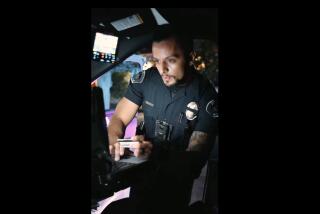Chief Orders Smaller Flashlights
- Share via
Los Angeles’ police chief said he would direct officers to switch to smaller and lighter flashlights after a divided Police Commission on Tuesday deferred the politically charged decision to him.
Chief William J. Bratton said the catalyst for the change was the case of car-theft suspect Stanley Miller, who was repeatedly struck with an oversized 2-pound metal flashlight by a Los Angeles Police Department officer during a televised incident 10 months ago.
Bratton said the new flashlights would be 10 inches long or shorter, would weigh less than 12 ounces and, unless shorter than 6.9 inches, must be made of rubber or polymer.
More than 250 recruits in training will receive smaller flashlights in the coming weeks, he said. Some officers may already have their own flashlights that meet the new specifications.
But the next step, Bratton said, would be to get approval from the City Council for about $500,000 in extra funding in next year’s budget to provide all 9,200 officers with the new flashlights.
The LAPD will then seek bids from the half a dozen or so companies that make such lights. Bratton said he expected it would take six months to a year to get them issued to the entire force.
Bratton said the change is in “the best interest of this department, and in the best interest of the city.”
“Too many officers are carrying flashlights in lieu of batons. The flashlight is not a baton,” Bratton said. “If you hit someone with one of those larger flashlights, it is like hitting them with a ball-head hammer.”
On Tuesday, a majority of the five-member Police Commission voted to give Bratton the power to decide the issue himself, instead of approving his proposal on new flashlight specifications.
In his dissenting vote, commission Vice President Alan Skobin warned that eliminating the larger flashlights would remove a defense weapon that is often the only item in an officer’s hand during an attack in darkness.
“I talked to an officer, and the only thing that saved him having his skull cracked in was his flashlight,” he said. “I don’t think any matter has made me as sick in the stomach as this.”
Skobin said a policy the commission adopted in January forbidding officers from using flashlights as weapons except when other alternatives are not feasible was an adequate response to the Miller beating.
Bratton first called for a change two months after TV news helicopters videotaped the June 23 incident in which LAPD Officer John Hatfield struck Miller with his metal flashlight 11 times after a car chase and foot pursuit. Dissatisfied with existing flashlights, Bratton tried to have a custom model designed, but discovered that existing patents made that impossible.
The smaller lights -- four of which he displayed Tuesday -- will fit on officers’ belts, giving them one fewer thing to have to grab as they jump out of their patrol cars, Bratton said.
They also will reduce the weight an officer has to carry, Bratton said, adding that he also plans to introduce a lighter equipment belt soon. He said the 6-ounce flashlights for new recruits would have the same candlepower as the large flashlights used in the Miller arrest.
“I think some officers will be upset, but the vast majority of officers will adjust very, very quickly,” Bratton said.
Corina Lee, a director with the Police Protective League, which represents the 9,200 officers, told commissioners that every time a tool is taken away, officers have fewer options for dealing with dangerous suspects.
Bratton noted, however, that the commission approved two new methods Tuesday for dealing with suspects fleeing in cars: the use of road spike strips to deflate tires and the pursuit intervention technique, in which a cruiser strikes the rear of a suspect’s vehicle, causing it to spin to a halt.
The use of heavy flashlights as weapons has been a matter of controversy at least since a 1985 study in the Journal of Police Science and Administration, which found that they cause more injuries than police batons do. Other departments -- including those in Philadelphia, Chicago, Miami and Detroit -- have banned larger flashlights.
In Los Angeles, commission President David Cunningham III said Bratton, a 35-year veteran of law enforcement, was in the best position to make the decision.
“We’re not taking away the ability to use a flashlight,” Cunningham said. “We’re simply adopting a more enlightened approach to it.”
More to Read
Sign up for Essential California
The most important California stories and recommendations in your inbox every morning.
You may occasionally receive promotional content from the Los Angeles Times.











